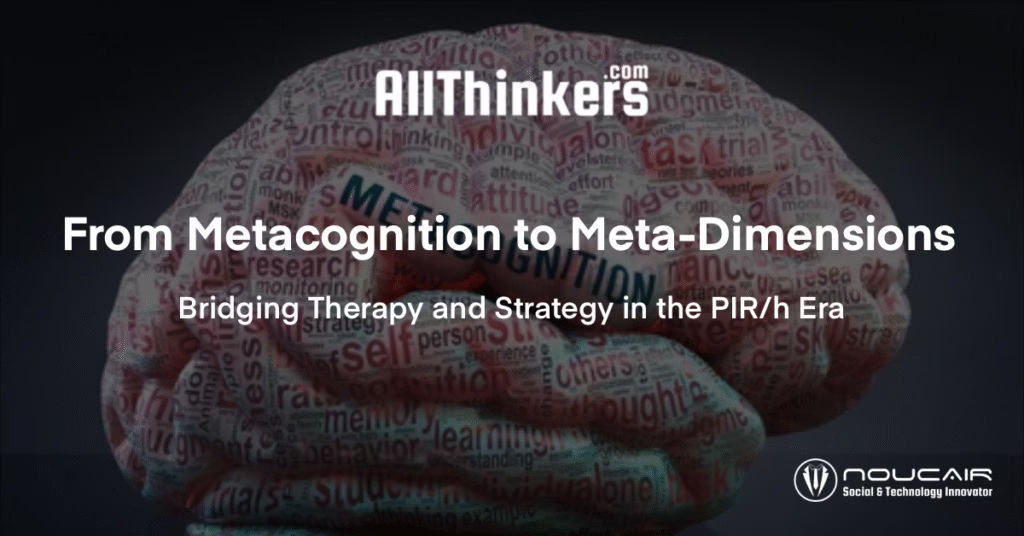In a world accelerating toward complexity and hyperconnectivity, human cognition is under increasing pressure. Artificial Intelligence (AI), high-speed data systems, and constant informational noise are reshaping the very structure of thought. While some adapt seamlessly, others fall into psychological traps such as overthinking, anxiety, and indecision. To navigate this reality, we need frameworks that connect psychological well-being with strategic thinking. This article bridges Adrian Wells’ Metacognitive Therapy (MCT) with PIR/h Theory, introducing a new conceptual synthesis for AllThinkers.com.
Metacognitive Therapy: A Strategic Model for Mental Regulation
Metacognitive Therapy focuses on the way people think about their thoughts. It identifies patterns like the Cognitive Attentional Syndrome (CAS), a mental state characterized by worry, rumination, and threat monitoring. These are driven by metacognitive beliefs such as “I can’t control my thoughts” or “Worrying helps me solve problems.”
MCT offers tools to:
- Identify dysfunctional metacognitive beliefs
- Break free from CAS loops
- Develop flexible attentional control
- Regain control over the thought process itself
These principles are not just therapeutic—they are strategic.
PIR/h Theory: Dimensional Thinking in the Age of AI
PIR/h stands for Process, Intelligence, Reality / human. It is a theoretical framework developed to explore how dimensional thinking, human depth, and the speed of AI can be fused. It suggests that intelligence is no longer linear or confined to the individual but operates across dimensions—emotional, temporal, conceptual—and through interfaces with intelligent systems.
In PIR/h:
- Human depth is the capacity for layered reflection and meaning-making
- Dimensional navigation is the ability to shift between abstraction levels
- AI speed represents external cognitive acceleration
The Fusion: Metacognitive Awareness as Dimensional Navigation
Metacognition is the internal compass that enables humans to navigate mental dimensions. When layered into PIR/h, it acts as the regulator that:
- Balances human depth with external speed
- Interrupts dysfunctional thought spirals (CAS)
- Enhances awareness of where one is thinking—from which layer or abstraction level
We can think of metacognitive training as an “Operating System” for PIR/h intelligence.
Escaping CAS and Activating Strategic Flow
Where CAS traps individuals in emotional loops, PIR/h aims for adaptive, multi-dimensional flow states. MCT provides the cognitive levers to:
- Recognize when one is looping versus processing
- Shift attention strategically (internal vs. external)
- Replace maladaptive metacognitive beliefs with empowering ones
This allows thinkers and leaders to operate from higher cognitive dimensions.
Toward a Meta-Cognitive AI Interface
One of the most exciting applications is a conceptual AI layer that acts as a metacognitive partner. Imagine a digital tool that prompts users to:
- Reflect on their current mode of thought
- Reframe cognitive loops
- Adjust their dimensional perspective before taking action
Such tools could amplify human agency in an AI-driven world.
Conclusion
The synthesis of Metacognitive Therapy and PIR/h Theory creates a pathway toward deeper, more adaptive thinking. By cultivating metacognitive awareness, individuals and teams can navigate complexity, align human depth with AI speed, and engage in strategic innovation. AllThinkers.com invites you to explore this fusion further—and to become architects of a more conscious and capable future.

Definitions:
- Human Depth (HD): The individual’s capacity for reflection, emotional insight, and layered understanding.
- Metacognitive Awareness (MA): The ability to observe, regulate, and reframe one’s own thinking processes.
- Dimensional Navigation (DN): The mental flexibility to move across different levels of abstraction, scale, or perspective.
- AI Speed (AIS): The external augmentation of cognition through fast data processing, pattern recognition, and automation.
Interpretation:
Strategic Intelligence results from the fusion of two forces: the internal mastery of thought through human depth and metacognition, and the external acceleration of cognition through dimensional flexibility and artificial intelligence. This equation represents how individuals and collectives can operate more consciously and strategically in complex environments.


